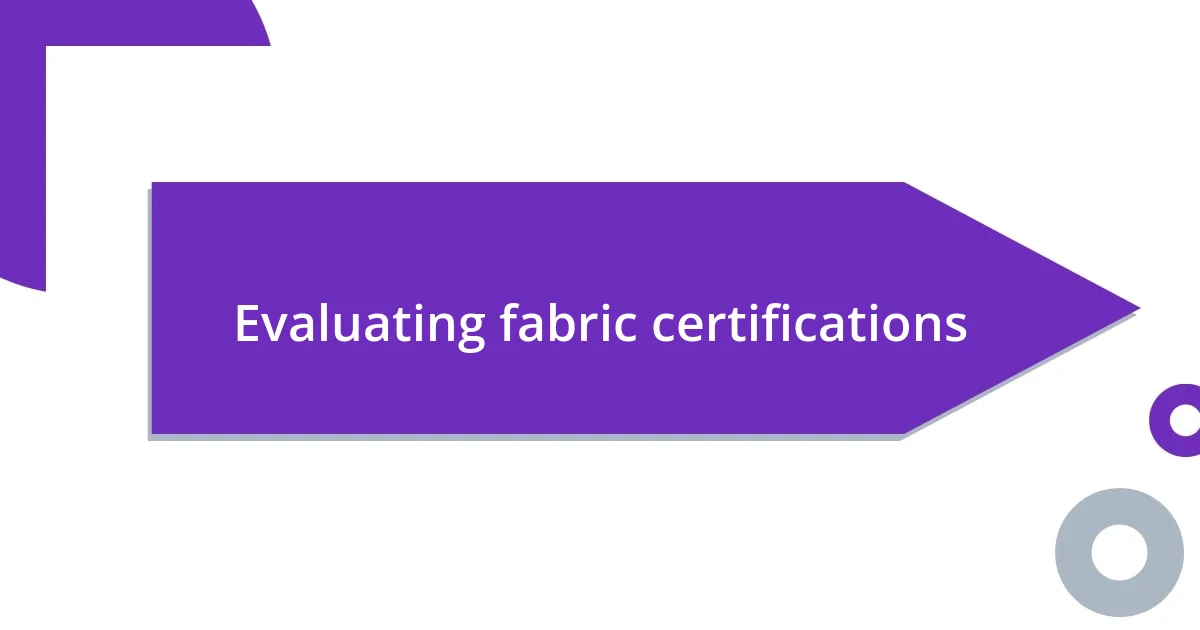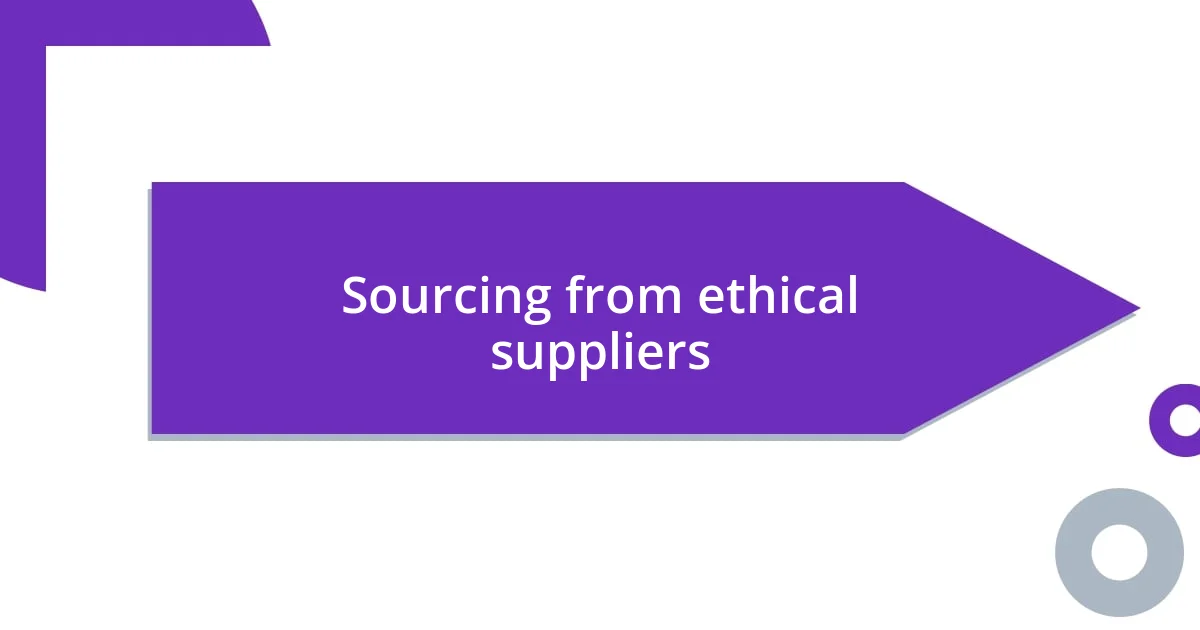Key takeaways:
- Sustainable fabrics combine style and environmental responsibility, allowing consumers to make mindful fashion choices.
- Understanding certifications like GOTS and OEKO-TEX helps in evaluating the sustainability and ethical practices behind the fabrics.
- Sourcing from ethical suppliers and making informed purchasing decisions can elevate personal connections to clothing and contribute to a sustainable future.

Understanding sustainable fabrics
Sustainable fabrics are all about making mindful choices that not only enhance fashion but also protect our planet. One day, while sifting through my wardrobe, I realized the impact of my choices — I had pieces made from conventional materials that were not just harmful to the environment but also felt uninspiring. Isn’t it fascinating how the fabric we choose can tell a story, not just about style but about our values?
When I first discovered fabrics like organic cotton and Tencel, I was amazed by how luxurious they felt against my skin, yet I knew they were produced with far less environmental impact. It’s moments like these that spur a question in my mind: Why compromise comfort when you can have both style and sustainability? Understanding the source and process of these fabrics transformed my shopping habits and deepened my connection to the clothes I wear.
Every time I touch a piece made from recycled materials, I can’t help but feel a sense of pride. It’s like each thread holds a narrative of conscious decision-making and innovation. This awareness helps me appreciate the journey behind the fabric, reminding me that every small choice contributes to a larger purpose. Through this exploration, I’ve learned that understanding sustainable fabrics is not just about what I wear; it’s about how I live.

Types of sustainable fabrics
When I dive into the world of sustainable fabrics, I’m often overwhelmed by the variety that exists. It’s exciting to think about the clothes I wear being made from materials that are not only eco-friendly but also bring unique textures and functions. For example, bamboo is a fabric that feels unbelievably soft against the skin and, best of all, it’s naturally biodegradable and grows quickly without needing harmful pesticides. Each time I wear my bamboo shirt, I can’t help but smile, knowing that I chose a fabric that’s kind to both my wardrobe and the environment.
Here are some popular types of sustainable fabrics that I’ve come to appreciate:
- Organic Cotton: Grown without synthetic pesticides or fertilizers, it supports healthier farming practices.
- Tencel (Lyocell): Made from sustainably sourced wood pulp, it’s incredibly soft and biodegradable, with a closed-loop production process that recycles water and solvents.
- Hemp: This durable fabric requires minimal water and no pesticides. It has a unique texture and improves in softness over time.
- Recycled Polyester: Often made from plastic bottles, it helps reduce waste and pollution while creating comfortable, versatile clothing.
- Linen: Derived from the flax plant, it’s highly biodegradable, requires little water, and has natural anti-bacterial properties.
Each of these fabrics tells its own story, and every time I slip into something made from them, I feel more connected to the message of sustainability. It’s a journey that not only elevates my style but also aligns with my values.

Evaluating fabric certifications
Evaluating fabric certifications can feel like wandering through a maze, but I find it crucial to navigate this process. When I first started researching certifications like GOTS (Global Organic Textile Standard) and OEKO-TEX, I was pleasantly surprised to discover how these labels can guide my choices. GOTS not only guarantees organic materials but also emphasizes ethical labor practices, which resonates with my values about fair treatment in the fashion industry.
In my experience, certifications offer a transparent window into the manufacturing process. For instance, when I see the OEKO-TEX label on a garment, it reassures me that it’s free from harmful substances, making me more confident in my purchase. It’s a comforting thought knowing that what I’m wearing has been evaluated for safety and sustainability, allowing me to enjoy my fashion choices without a hint of guilt.
As I compiled a list of certifications, I couldn’t help but reflect on how each label represents a commitment to better practices. It’s not just about pretty fabrics; it’s about a movement towards a more sustainable future. Understanding what each certification entails empowers me as a consumer and encourages me to choose wisely. After all, each conscious decision contributes to the bigger picture of environmental change.
| Certification | Description |
|---|---|
| GOTS | Guarantees organic textiles from harvesting to production, including ethical labor practices. |
| OEKO-TEX | Ensures textiles are free from harmful chemicals and safe for human use. |
| Fair Trade | Focuses on ensuring fair wages and working conditions for producers. |
| Recycled Content | Confirms the fabric is made from recycled materials, promoting waste reduction. |
| Cradle to Cradle | Certifies products designed with sustainability principles, allowing for recycling and reuse. |

Considering environmental impact
When I think about the environmental impact of the fabrics I choose, it’s hard not to feel a sense of responsibility. I remember my first pair of organic cotton jeans; the moment I slipped them on, I felt lighter, knowing that my choice was good for the planet. Each time I make a purchase, I ask myself: “What footprint am I leaving behind?” This self-reflection has really shaped my consumer habits and opened my eyes to how every piece of clothing contributes to a larger narrative of sustainability.
The production of fabrics can be incredibly resource-intensive, and I like to imagine where the materials come from. For instance, while browsing for hemp shirts, I often wonder about the fields where the flax grows. What kind of ecosystem is supported by that cultivation? Understanding the ripple effect of my choices makes me more intentional. By opting for fabrics that require less water and no pesticides, I feel like I’m doing my part to protect our precious natural resources.
I also enjoy learning about the life cycle of the fabrics I wear. I’ve found that thinking about the end of a garment’s life is just as crucial as its beginning. Recently, I came across some recycled polyester clothing that inspired me. It struck me deeply that these pieces were once plastic bottles, now transformed into something beautiful instead of ending up in a landfill. Isn’t it fascinating how we can give new life to waste? That sense of circularity in fashion resonates strongly with my goal to promote a more sustainable world.

Assessing comfort and usability
When I assess comfort and usability in sustainable fabrics, my hands often take the lead. I remember feeling the soft touch of bamboo fabric for the first time, and it felt like a gentle hug against my skin. It made me realize that comfort is not just about how clothes look; it’s also about how they feel and move with you throughout the day. Is there anything more frustrating than wearing something that feels restrictive or scratchy? I’ve learned that the right fabric can enhance my daily experiences, whether I’m working from home or enjoying a weekend adventure.
Fit and breathability are also key aspects I consider. For example, I once bought a linen shirt, drawn in by its sustainable credentials, but was pleasantly surprised by its lightweight, breathable quality. It was perfect for those hot summer days, and I could wear it comfortably from breakfast to evening outings without feeling sticky and uncomfortable. Each time I reach for it, I appreciate how thoughtful choices in fabric can make everyday life more enjoyable.
Moreover, practicality doesn’t take a backseat for me—durability plays a vital role too. I recall purchasing a pair of recycled denim jeans that have become my go-to, not just for their great fit but because they’ve held up brilliantly through countless washes and wears. Isn’t it comforting to know that your purchasing choices lead to longer-lasting pieces? As I look for versatile options that blend comfort and usability, I find myself increasingly motivated to seek out fabrics that can stand the test of time.

Sourcing from ethical suppliers
Sourcing materials from ethical suppliers is essential to my sustainable fashion journey. I remember a time when I was enchanted by a collection of organic fabrics but felt that something was missing in my understanding of their origins. Delving into how these suppliers ensure fair wages and safe working conditions really added depth to my connection with the clothes. It made me wonder: do we ever fully appreciate the stories behind the seams?
One experience that really opened my eyes was a visit to a local artisan workshop where I saw firsthand how artisans sourced natural dyes from local plants. The vibrant colors were alive with the essence of their environment, and I was fascinated by the craftsmanship involved. It made me realize that every piece has a history and a human touch that supports communities. When I choose suppliers, I not only prioritize sustainability but also seek connections to those passionate about preserving traditional methods.
Now, when I think about the fabric retailers I support, I ask myself about their ethical practices. Have they established transparent supply chains? Do they empower their workers? Just recently, I stumbled upon a brand that openly shared stories about the farmers and craftsmen who contribute to their fabrics. Reading their narratives ignited a spark in me, reinforcing the idea that my choices can uplift others. It’s this kind of knowledge that transforms fabric shopping into a more meaningful experience, don’t you think?

Making informed purchasing decisions
Making informed purchasing decisions about sustainable fabrics often feels like unearthing hidden gems. I vividly recall an afternoon spent browsing through fabric swatches, where I stumbled upon a beautifully textured fabric made from organic cotton. Touching it felt like a moment of clarity; I knew it was the right choice. But it wasn’t just the texture that drew me in—it was the story behind it. Knowing that I was supporting environmentally friendly practices played a significant role in my decision.
As I weigh the environmental impact of my purchases, I’ve learned to ask the questions that lead to deeper insights. For instance, while shopping for a new dress, I paused to consider how much water was used in the production of conventional fabrics. I can still hear the retailer’s response when I inquired about the sourcing of their materials; they shared how their hemp was grown with far less water compared to cotton. That information was like a beacon, guiding me towards a choice that aligned with my values and made me feel empowered.
I also find myself reflecting on the broader implications of my fabric choices. It’s always been important to me that my wardrobe does not contribute to environmental degradation. Recently, I faced the temptation of a fast-fashion piece that caught my eye, but I could hear my own voice reminding me of the landfill impact of these fleeting trends. I chose to walk away, comforted by the knowledge that every decision matters. Isn’t it reassuring to think that our conscious choices can shape a more sustainable future in fashion?














